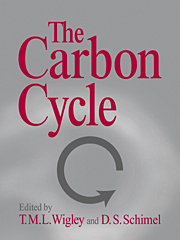Book contents
- Frontmatter
- Contents
- Preface
- Acknowledgments
- Contributors to the 1993 Global Change Institute
- I INTRODUCTION
- II THE MISSING CARBON SINK
- III PALEO-CO2 VARIATIONS
- IV MODELING CO2 CHANGES
- 14 Future Fossil Fuel Carbon Emissions without Policy Intervention: A Review
- 15 The Future Role of Reforestation in Reducing Buildup of Atmospheric CO2
- 16 Simple Ocean Carbon Cycle Models
- 17 Very High Resolution Estimates of Global Ocean Circulation, Suitable for Carbon Cycle Modeling
- 18 Effects of Ocean Circulation Change on Atmospheric CO2
- 19 Box Models of the Terrestrial Biosphere
- 20 Impacts of Climate and CO2 on the Terrestrial Carbon Cycle
- 21 Stabilization of CO2 Concentration Levels
- Part V Appendixes
- Index
16 - Simple Ocean Carbon Cycle Models
from IV - MODELING CO2 CHANGES
Published online by Cambridge University Press: 04 December 2009
- Frontmatter
- Contents
- Preface
- Acknowledgments
- Contributors to the 1993 Global Change Institute
- I INTRODUCTION
- II THE MISSING CARBON SINK
- III PALEO-CO2 VARIATIONS
- IV MODELING CO2 CHANGES
- 14 Future Fossil Fuel Carbon Emissions without Policy Intervention: A Review
- 15 The Future Role of Reforestation in Reducing Buildup of Atmospheric CO2
- 16 Simple Ocean Carbon Cycle Models
- 17 Very High Resolution Estimates of Global Ocean Circulation, Suitable for Carbon Cycle Modeling
- 18 Effects of Ocean Circulation Change on Atmospheric CO2
- 19 Box Models of the Terrestrial Biosphere
- 20 Impacts of Climate and CO2 on the Terrestrial Carbon Cycle
- 21 Stabilization of CO2 Concentration Levels
- Part V Appendixes
- Index
Summary
Abstract
Simple ocean carbon cycle models are constructed to reflect the interaction between the atmospheric and oceanic components of the global carbon cycle. In this chapter, (1) a two-box ocean model is used to demonstrate principles used in constructing simple ocean carbon cycle models, (2) a variety of simple ocean carbon cycle models are described, and (3) results of various models are shown and compared. Physical transport of carbon in simple ocean models is not based on first principles, but is accomplished using parameterizations calibrated with carbon isotopes and/or other tracer fields. Well-calibrated simple ocean carbon cycle models may yield CO2 absorption predictions that are more accurate than predictions based on ocean general circulation models. Nevertheless, ocean general circulation models may be required to estimate the impact of climate and ocean circulation feedbacks on CO2 fluxes between the ocean and atmosphere.
Introduction
The activities of Homo sapiens have been significantly perturbing the global carbon cycle for the past several hundred years. From 1750 to 1990, the burning of fossil fuels and the clearing of forests has released approximately 380 Gt C as CO2 into the atmosphere, but only approximately 160 Gt C remains there (Sundquist, 1993); the rest has been absorbed by the oceans and terrestrial ecosystems. Ocean models indicate that the oceans have absorbed approximately 140 Gt C, leaving approximately 80 Gt C unaccounted for (perhaps indicating an additional sink in terrestrial ecosystems).
- Type
- Chapter
- Information
- The Carbon Cycle , pp. 199 - 211Publisher: Cambridge University PressPrint publication year: 2000
- 4
- Cited by



